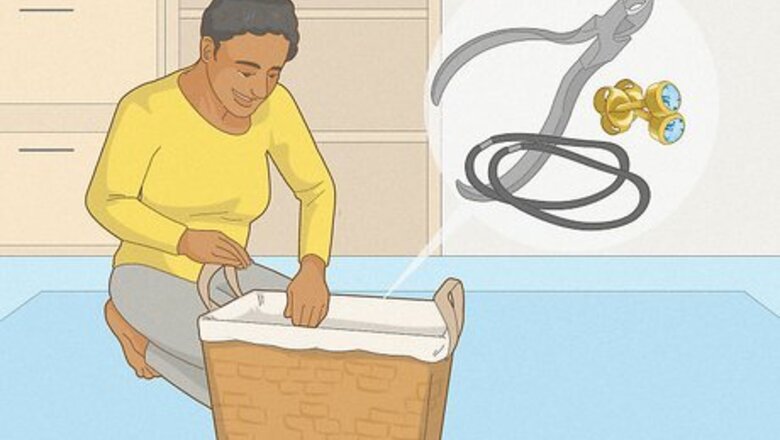
views
Starting at the Bottom

Keep floors and low surfaces free of small objects. If a young child can fit something in their mouth, there is a chance they could choke on it. Make sure any small objects are kept up off the floor and out of a young child's reach. Regularly vacuum your living room floor to pick up any small items you might not notice visually. Even items like deflated latex balloons or forgotten paperclips could lead to a choking hazard if they are left on the floor for a young child to find and ingest. Make sure you inspect your young child's toys regularly. Small pieces may fall off and become choking hazards. If you notice small pieces from a toy on the floor, discard that toy and the broken pieces immediately. Move furniture to pick up small objects and vacuum. A young child could crawl under and find stuff you may have missed. Items like old batteries, loose paper, and buttons from the remote might have found their way behind or under the furniture.

Secure electrical cords. Use zip ties, Velcro, or cord straps to tie up all long cords and secure them out of a young child's reach. If these cords remain on the floor, your baby might become entangled in them or pull on them. Wrap excess cord length and secure it with a zip tie. Then, hook the cord to the wall using a Command hook. Just make sure you hook the cord high enough that a young child won’t be able to reach it to pull it down. To best keep a young child from pulling on electrical cords, you should move furniture in front of the cords and the outlets they plug into. This will block access to the cord and the outlet all at once.

Cover all electrical outlets. There are many different options for covering your outlets, including moving furniture in front of them. But, if rearranging furniture isn’t an option, you can use other methods. Use plastic outlet covers in all outlets around your house. You can buy these at just about any grocery or department store. These covers will plug right into the outlet, and are difficult for young children to grip and pull out because they lie flat against it. You can install baby-safe electrical outlet plates over your existing outlets to prevent young children from getting to them. They clip right over the original cover. To use the outlet, just put the prongs in place, slide the cover to the side, and plug your cord in. These might be more visually appealing than plastic covers, and you would be less likely to lose them or forget to put them back in after using the outlet.
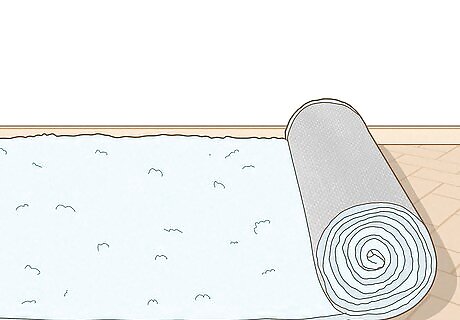
Make the floor softer. If your house's floors are made of a hard material (such as hardwood or tile), your baby will need a softer place to sit and play. You can use anything from baby play mats to area rugs to soften the floor for a baby. You could even go a more permanent route and install new carpeting. Playmats and gyms are great for young children of different ages and developmental stages. They come in many different styles and sizes, and offer a soft place to lie down and play, as well as built in entertainment like toys, lights, and music to engage the children and keep them happy. If you decide to go with an area rug or carpeting, choose something in a darker shade. Young children are prone to messes like spills and accidents, so a darker colored rug would allow you to better mask stubborn stains and leftover messes.
Babyproofing Windows and Furniture
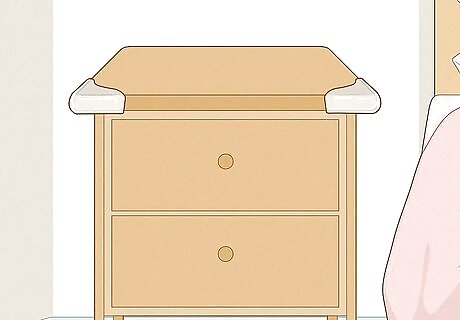
Place corner covers or bumpers on the sharp edges of all furniture. These can be purchased in the baby care aisle of your local big box store. They come in many different styles and colors, and are easily applied and can be later removed when the child is older. Some of these even come in fun shapes, like animals or cartoon characters. Depending on how much you want to give up your own personal design style for your kids, you might consider these to make them more fun. Make sure you purchase enough of these for all sharp corners and edges in your living room. This includes coffee tables, end tables, TV stands, shorter bookcases or shelving units, benches, and chairs.

Secure bookcases and other tall furniture to the wall. Babies and toddlers tend to climb or pull on furniture, and with that comes a risk of that furniture falling over on them and hurting them. Newer furniture often comes with kits to secure the piece to the wall, or these kits can be purchased at hardware stores. You can also buy furniture straps to secure your end tables and bookcases to the wall. These straps are easy to apply and use, and are durable and reliable. They are also easily removed or released if you want to redecorate or rearrange your furniture.

Keep drawers closed and secure. If you have any furniture in your living room that has drawers, make sure you keep them closed. Use straps or locks to keep your child from pulling these drawers out. Think about potentially hazardous items that you could have in your drawers, such as: remotes, items with small pieces, fragile items, candles, and especially sharp objects or lighters. You want to make sure a young child does not have access to these items. A child could potentially pull the drawers out and use them as a ladder to climb higher, resulting in injury. Keeping drawers closed and secure prevents this. One of the best methods to secure drawers in your living room is with easily installed magnetic locks. These kits often come with multiple locks and a single key. They are easily disabled (by you) when you need to get into the drawer, and won’t allow a child to open the drawer even a crack, which could get their fingers caught.

Secure the windows and their blinds/curtains as well. Regardless of how high or low to the ground your windows go, as the child grows, they might be able to reach the latch of the window, and depending on the window, the child could escape the house. You want to make sure your windows are secure to prevent injury or the child unsafely escaping. Depending on the type of windows you have, your method of babyproofing them will differ. For example if you have sliding windows, or windows that slide to the left or right to open, you will want to put a bar in your window track to prevent the window from sliding open. Or, if you have hung windows that push up to open, you will want to make sure they stay in the locked position, and that the locks are secure. Wrap up and secure all cords hanging from things like blinds and draperies. These cords are dangerous for young children, as they could become entangled in them. Use zip ties and Command hooks to wind up excess cord lengths and hang them out of reach. Choose cordless window coverings when you are able to. Replace the glass in your windows with shatterproof glass, or use shatterproof linings like tempered glass or films to prevent glass from shattering and harming someone if it breaks. Install window guards to make sure your child cannot fall out of the window. These guards are essentially bars that will allow you to open your windows and let air in without worrying about your child falling out.
Securing Doors and Fixtures
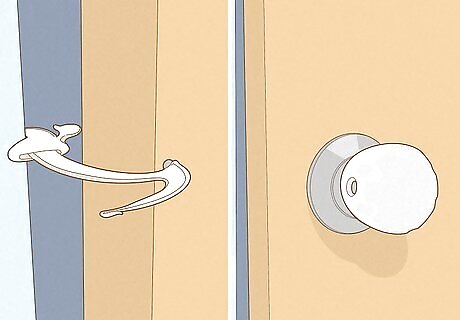
Secure all door handles and locks properly. Since the living room is often also where the front door is, you want to make sure that your growing baby or toddler cannot open the door. The child could get their fingers caught in the door, or even get out of the house if the handles and locks are not secure. There are many options for securing doors in your home to keep your child from getting injured, or from entering rooms they aren’t allowed in. One option is called a “Door Monkey,” which is a gadget that allows air to still move between rooms through a small gap in the door, but keeps the door from opening or closing any further. Use a cover on deadbolts to keep your baby or growing toddler from unlocking them. These are available in the baby care aisle of most stores. Door knob covers will prevent your child from turning round door knobs. Alternatively, you can simply close the door with a washcloth in the jamb, and your child will not be able to open it. As you close the door, place a washcloth between the door and the frame, and close the door on the cloth. This will keep the door in place should your child try to push it open, but you will be able to open it yourself with a little push and pulling the washcloth tight.

Secure your screen or storm door. If you have a screen door, use a metal mesh or grill on the bottom half to keep your child from falling through or pushing the screen out. Screens are not particularly sturdy or safe, so using a metal grill over the lower portion can reinforce it. You can purchase these at your local hardware or home improvement store. They often clip right into your existing screen door and will allow you to keep air flowing in while still keeping your child safe. There are also companies that will install special types of doors. Many companies have the option for a door that comes equipped with a metal grill on the lower half of the screen.

Place a guard or barrier around fireplaces, space heaters, and radiators. Even if these devices are not in use, they could pose a danger to your child, so you want to make sure you keep them secure. There are many ways to cover your fireplace. One more stylish way to babyproof a fireplace is to cover it with a panel you have painted with chalkboard paint. You could also fill it with books for decoration, or cover it with a piece of sheet metal. If you want to leave your fireplace functional while still protecting your child from it, you will want to install a gate with a wide girth that will keep your child away from both the hearth and the fire while the fireplace is in use. Radiator covers can help keep your child’s hands away from a hot radiator while it is in use, and keep the child from getting their hands stuck in it if it’s turned off. You can buy radiator covers in a variety of styles, or even make your own.

Verify whether any household plants are poisonous. If you have plants in your living room, you will want to make sure they can’t be harmful to your child. Your child could potentially become poisoned by eating soil from the pot, ingesting leaves or blossoms, or even from simply touching the plant. Even some of the most common household plants can be harmful to your child. Pothos, Peace Lily, and Caladium plants are all highly toxic to children, and even pets. If you have any of these in your living room, make sure you put them out of reach. Swapping live plants out for plastic plants is an option, but even plastic plants pose their threats. Children could pull off leaves or small pieces, which are choking hazards. It is best to keep all plants, real or fake, out of reach.

Place breakable items on high shelves. Items that are expensive or easily broken should always be kept out of reach from a baby or young toddler. A child that young can easily do damage to both the object and themselves should they get ahold of it. You might usually keep items such as vases, decorative items, or even remote controls on your coffee and end tables. Move these items to higher shelves and out of reach of young children. They could potentially cause harm if they are broken, or if small pieces are ingested. You can even try installing high, floating shelves to place these items on. This is a stylish alternative to putting your decorative items away until your child is older.















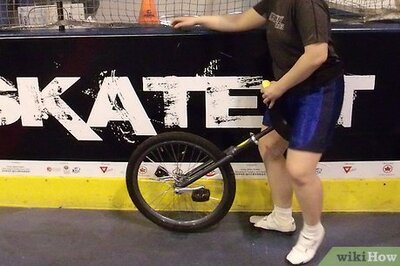


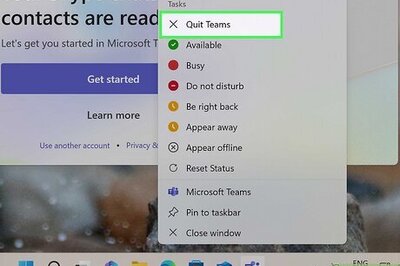

Comments
0 comment